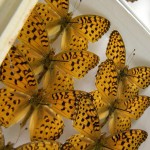Last year the Triplehorn Insect Collection received a large donation of butterflies from Mr. David Parshall. More than 50,000 pinned specimens, and many thousands more in paper envelopes. You might have read about it on the Pinning Block (here and here.) We have also posted some photos of the collection move on Twitter.
We have specimens of all insect orders and from all regions of the world, but because we never had a faculty or staff who specialized on Lepidoptera, our moth and butterfly collection was not nearly as big as, for example, our beetle or leafhopper collections. This has changed with the addition of the massive Parshall donation.
The Parshall collection is a complete collection of the butterfly and skipper species found in the state of Ohio. It really stands out, though, because it also contains a huge number of specimens collected in the Arctic Canada and Alaska. (Imagine chasing butterflies in Churchill, Manitoba with the very real threat of polar bears around you! Makes the butterfly hunt just a little more interesting, don’t you think?)
The National Science Foundation has recently funded a large project called the “Lepidoptera of North America Network” (LepNet). This project, which just began this month, is a collaborative effort of 29 institutions across the United States with the goal of making 2.1 million butterfly specimen records freely available on the Internet. If that were not enough, LepNet also aims to produce over 95,000 images of the moth and butterfly species that these data refer to. The project is being coordinated by Northern Arizona University, and the Triplehorn Insect Collection will participate through a subcontract to “digitize” the Parshall collection.
Digitization, for us, means capturing and storing the information contained on each specimen label and storing it in our xBio:D database. And from there, to the world!
Every specimen in a collection has (or should have!) a label with information on where it was captured, when, and by whom. Often we find additional biological data on the labels, like the host plant that an insect was feeding on, the habitat in which it was collected, or the method by which it was collected.
Taken together, all of these bits of information tell us a lot about the geographic distribution of species going as far back as the late 19th Century, the flight period of the adults, and much more. We have not even scratched the surface of all the knowledge we can obtain from biological collections. On July 13th a story was published in the New York Times about a team of ecologists using these same data for plants to find out how many different tree species exist in the Amazon Forest (the researchers found over 11,000!).
Digitization can also mean taking pictures of the specimens. But with millions of butterfly specimens in collections we cannot reasonably take and store several pictures of each and every one of them. So the goal of LepNet is smaller, but 95,000 is still a big number.
The Triplehorn collection’s own contribution to LepNet is more modest, but important nevertheless. The Parshall collection’s strength in Arctic butterflies is particularly interesting and even before we had fully unpacked the collection after the move the specimens were already being used by scientists (see Warren et. al., 2016).
In an era of climate change, knowing where those butterflies used to be found in years and decades past will give a good impression of the impact of environmental change.
Drawer full of colorful Lycaenidae butterflies.
Reference:
Warren, Andrew D.; Nakahara, Shinichi; Lukhtanov, Vladimir A.; Daly, Kathryn M.; Ferris, Clifford D.; Grishin, Nick V.; Cesanek, Martin; Pelham, Jonathan P. 2016. A new species of Oeneis from Alaska, United States, with notes on the Oeneis chryxuscomplex (Lepidoptera: Nymphalidae: Satyrinae). The Journal of Research on the Lepidoptera (The Lepidoptera Research Foundation, Inc.) 49: 1–20
About the Author: Luciana Musetti is an Entomologist and Curator of the Triplehorn Insect Collection.




